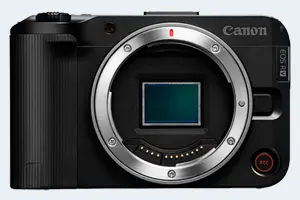Canon R50 V vs Sony RX100 VII
The Canon EOS R50 V and the Sony Cyber-shot DSC-RX100 VII are two digital cameras that were announced, respectively, in March 2025 and July 2019. The R50 V is a mirrorless interchangeable lens camera, while the RX100 VII is a fixed lens compact. The cameras are based on an APS-C (R50 V) and an one-inch (RX100 VII) sensor. The Canon has a resolution of 24 megapixels, whereas the Sony provides 20 MP.
Below is an overview of the main specs of the two cameras as a starting point for the comparison.

Check R50 V price at
amazon.com

Check RX100 VII price at
amazon.com
Going beyond this snapshot of core features and characteristics, what are the differences between the Canon EOS R50 V and the Sony Cyber-shot DSC-RX100 VII? Which one should you buy? Read on to find out how these two cameras compare with respect to their body size, their imaging sensors, their shooting features, their input-output connections, and their reception by expert reviewers.
Body comparison
An illustration of the physical size and weight of the Canon R50 V and the Sony RX100 VII is provided in the side-by-side display below. The two cameras are presented according to their relative size. Three consecutive views from the front, the top, and the rear side are shown. All size dimensions are rounded to the nearest millimeter.
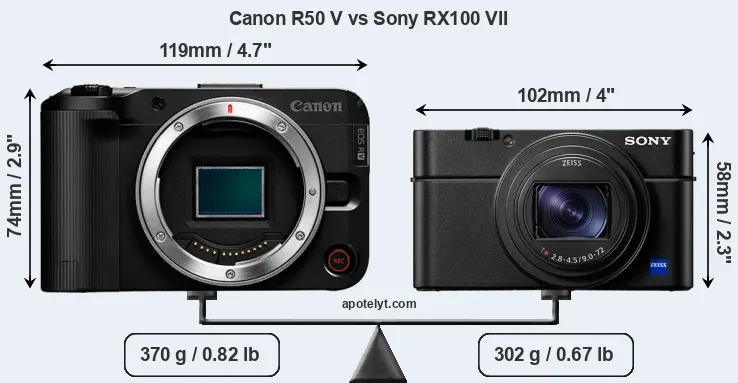
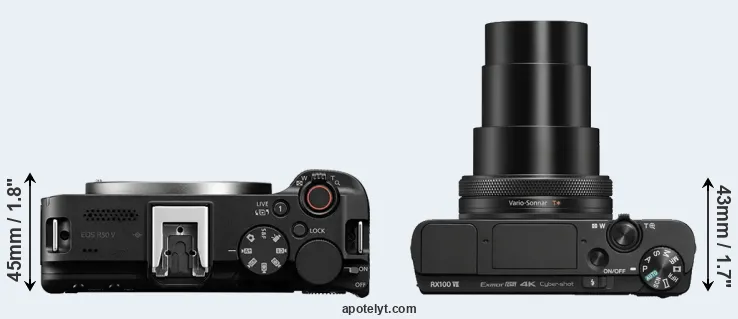
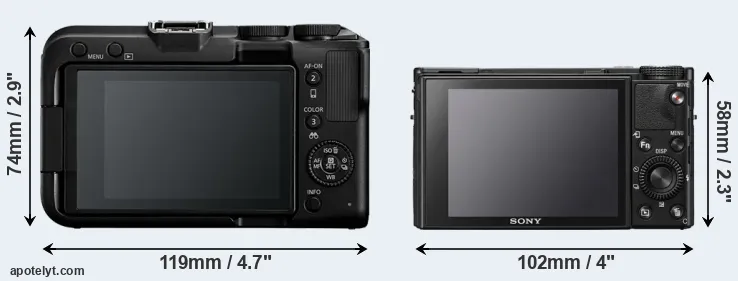
If the front view area (width x height) of the cameras is taken as an aggregate measure of their size, the Sony RX100 VII is considerably smaller (33 percent) than the Canon R50 V. In this context, it is worth noting that neither the R50 V nor the RX100 VII are weather-sealed.
The above size and weight comparisons are to some extent incomplete and possibly misleading, as the RX100 VII has a lens built in, whereas the R50 V is an interchangeable lens camera that requires a separate lens. Attaching the latter will add extra weight and bulk to the setup.
Concerning battery life, the R50 V gets 390 shots out of its Canon LP-E17 battery, while the RX100 VII can take 260 images on a single charge of its Sony NP-BX1 power pack. The battery packs of both cameras can be charged via USB, which can be very convenient when travelling.
The following table provides a synthesis of the main physical specifications of the two cameras and other similar ones. In case you want to display and compare another camera duo, you can use the CAM-parator app to select your camera combination among a large number of options.

| Camera Model |
Camera Width |
Camera Height |
Camera Depth |
Camera Weight |
Battery Life |
Weather Sealing |
Camera Launch |
Launch Price |
Street Price |
||
|---|---|---|---|---|---|---|---|---|---|---|---|
| 1. | Canon R50 V | 119 mm | 74 mm | 45 mm | 370 g | 390 | n | Mar 2025 | EUR 759 | amazon.com | |
| 2. | Sony RX100 VII | 102 mm | 58 mm | 43 mm | 302 g | 260 | n | Jul 2019 | EUR 1 299 | amazon.com | |
| 3. | Canon 250D | 122 mm | 93 mm | 70 mm | 449 g | 1070 | n | Apr 2019 | EUR 549 | amazon.com | |
| 4. | Canon G7 X Mark II | 106 mm | 61 mm | 42 mm | 319 g | 265 | n | Feb 2016 | EUR 685 | ebay.com | |
| 5. | Canon G7 X Mark III | 105 mm | 61 mm | 41 mm | 304 g | 235 | n | Jul 2019 | EUR 779 | amazon.com | |
| 6. | Canon M3 | 111 mm | 68 mm | 44 mm | 366 g | 250 | n | Feb 2015 | EUR 749 | ebay.com | |
| 7. | Canon M6 | 112 mm | 68 mm | 45 mm | 390 g | 295 | n | Feb 2017 | EUR 799 | ebay.com | |
| 8. | Canon M50 | 116 mm | 88 mm | 59 mm | 390 g | 235 | n | Feb 2018 | EUR 779 | ebay.com | |
| 9. | Canon M50 Mark II | 116 mm | 88 mm | 59 mm | 387 g | 305 | n | Oct 2020 | EUR 599 | ebay.com | |
| 10. | Canon R10 | 123 mm | 88 mm | 83 mm | 429 g | 450 | n | May 2022 | EUR 979 | amazon.com | |
| 11. | Canon R50 | 116 mm | 86 mm | 69 mm | 375 g | 230 | n | Feb 2023 | EUR 829 | amazon.com | |
| 12. | Canon R100 | 116 mm | 86 mm | 69 mm | 356 g | 400 | n | May 2023 | EUR 579 | amazon.com | |
| 13. | Sony RX100 II | 102 mm | 58 mm | 38 mm | 281 g | 350 | n | Jun 2013 | EUR 749 | ebay.com | |
| 14. | Sony RX100 III | 102 mm | 58 mm | 41 mm | 290 g | 320 | n | May 2014 | EUR 849 | ebay.com | |
| 15. | Sony RX100 IV | 102 mm | 58 mm | 41 mm | 298 g | 280 | n | Jun 2015 | EUR 1 149 | ebay.com | |
| 16. | Sony RX100 V | 102 mm | 58 mm | 41 mm | 299 g | 220 | n | Oct 2016 | EUR 1 199 | ebay.com | |
| 17. | Sony RX100 VI | 102 mm | 58 mm | 43 mm | 301 g | 240 | n | Jun 2018 | EUR 1 299 | ebay.com | |
| Note: Measurements and pricing do not include easily detachable parts, such as add-on or interchangeable lenses or optional viewfinders. | |||||||||||
Any camera decision will naturally be influenced heavily by the price. The listed launch prices provide an indication of the market segment that the manufacturer of the cameras have been targeting. Normally, street prices remain initially close to the MSRP, but after a couple of months, the first discounts appear. Later in the product cycle and, in particular, when the replacement model is about to appear, further discounting and stock clearance sales often push the camera price considerably down.
Sensor comparison
The size of the sensor inside a digital camera is one of the key determinants of image quality. A large sensor will tend to have larger individual pixels that provide better low-light sensitivity, wider dynamic range, and richer color-depth than smaller pixel-units in a sensor of the same technological generation. Moreover, a large sensor camera will give the photographer more control over depth-of-field in the image and, thus, the ability to better isolate a subject from the background. On the downside, larger sensors tend to be more expensive and lead to bigger and heavier cameras and lenses.
Of the two cameras under consideration, the Canon R50 V features an APS-C sensor and the Sony RX100 VII an one-inch sensor. The sensor area in the RX100 VII is 65 percent smaller. As a result of these sensor size differences, the cameras have a format factor of, respectively, 1.6 and 2.7. Both cameras have a native aspect ratio (sensor width to sensor height) of 3:2.
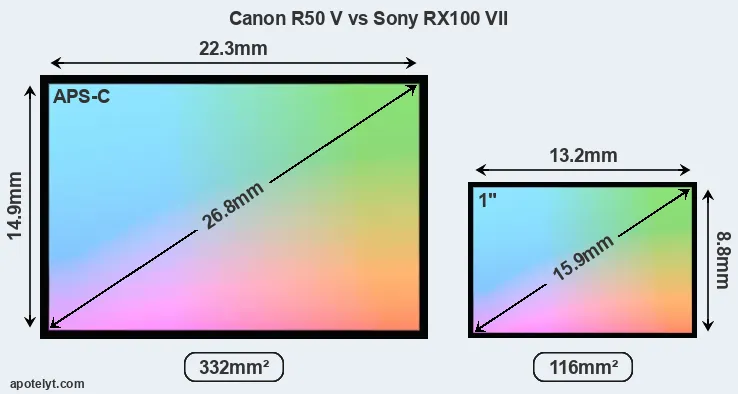
With 24MP, the R50 V offers a higher resolution than the RX100 VII (20MP), but the R50 V nevertheless has larger individual pixels (pixel pitch of 3.72μm versus 2.41μm for the RX100 VII) due to its larger sensor. Moreover, the R50 V is a much more recent model (by 5 years and 8 months) than the RX100 VII, and its sensor will have benefitted from technological advances during this time that further enhance the light gathering capacity of its pixels.
The resolution advantage of the Canon R50 V implies greater flexibility for cropping images or the possibility to print larger pictures. The maximum print size of the R50 V for good quality output (200 dots per inch) amounts to 30 x 20 inches or 76.2 x 50.8 cm, for very good quality (250 dpi) 24 x 16 inches or 61 x 40.6 cm, and for excellent quality (300 dpi) 20 x 13.3 inches or 50.8 x 33.9 cm. The corresponding values for the Sony RX100 VII are 27.4 x 18.2 inches or 69.5 x 46.3 cm for good quality, 21.9 x 14.6 inches or 55.6 x 37.1 cm for very good quality, and 18.2 x 12.2 inches or 46.3 x 30.9 cm for excellent quality prints.
The Canon EOS R50 V has a native sensitivity range from ISO 100 to ISO 32000, which can be extended to ISO 100-51200. The corresponding ISO settings for the Sony Cyber-shot DSC-RX100 VII are ISO 125 to ISO 12800, with the possibility to increase the ISO range to 80-25600.
In terms of underlying technology, the R50 V is build around a CMOS sensor, while the RX100 VII uses a BSI-CMOS imager. Both cameras use a Bayer filter for capturing RGB colors on a square grid of photosensors. This arrangement is found in most digital cameras.
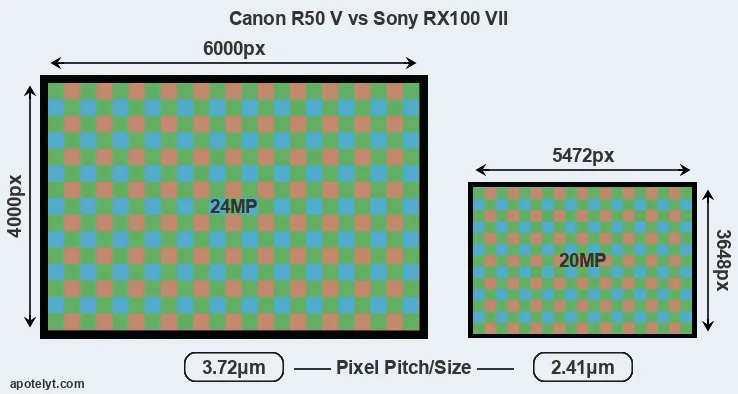
Since 2007, DXO Mark has published sensor performance measurements that have been derived using a consistent methodology. This service is based on lab testing and assigns an overall score to each camera sensor, as well as ratings for dynamic range ("DXO Landscape"), color depth ("DXO Portrait"), and low-light sensitivity ("DXO Sports"). The table below summarizes the physical sensor characteristics and sensor quality findings and compares them across a set of similar cameras.

| Camera Model |
Sensor Class |
Resolution (MP) |
Horiz. Pixels |
Vert. Pixels |
Video Format |
DXO Portrait |
DXO Landscape |
DXO Sports |
DXO Overall |
||
|---|---|---|---|---|---|---|---|---|---|---|---|
| 1. | Canon R50 V | APS-C | 24.0 | 6000 | 4000 | 4K/60p | 24.1 | 14.1 | 2383 | 85 | |
| 2. | Sony RX100 VII | 1-inch | 20.0 | 5472 | 3648 | 4K/30p | 21.8 | 12.4 | 418 | 63 | |
| 3. | Canon 250D | APS-C | 24.0 | 6000 | 4000 | 4K/25p | 23.9 | 13.4 | 1791 | 82 | |
| 4. | Canon G7 X Mark II | 1-inch | 20.0 | 5472 | 3648 | 1080/60p | 21.8 | 11.9 | 260 | 62 | |
| 5. | Canon G7 X Mark III | 1-inch | 20.0 | 5472 | 3648 | 4K/30p | 22.2 | 12.4 | 583 | 65 | |
| 6. | Canon M3 | APS-C | 24.0 | 6000 | 4000 | 1080/30p | 22.8 | 11.8 | 1169 | 72 | |
| 7. | Canon M6 | APS-C | 24.0 | 6000 | 4000 | 1080/60p | 23.4 | 12.6 | 1317 | 78 | |
| 8. | Canon M50 | APS-C | 24.0 | 6000 | 4000 | 4K/24p | 23.8 | 13.3 | 1684 | 81 | |
| 9. | Canon M50 Mark II | APS-C | 24.0 | 6000 | 4000 | 4K/24p | 24.0 | 13.6 | 1939 | 83 | |
| 10. | Canon R10 | APS-C | 24.0 | 6000 | 4000 | 4k/60p | 24.1 | 13.8 | 2085 | 84 | |
| 11. | Canon R50 | APS-C | 24.0 | 6000 | 4000 | 4K/30p | 24.1 | 13.9 | 2168 | 84 | |
| 12. | Canon R100 | APS-C | 24.0 | 6000 | 4000 | 4k/24p | 24.1 | 13.9 | 2197 | 84 | |
| 13. | Sony RX100 II | 1-inch | 20.0 | 5472 | 3648 | 1080/60p | 22.5 | 12.4 | 483 | 67 | |
| 14. | Sony RX100 III | 1-inch | 20.0 | 5472 | 3648 | 1080/60p | 22.4 | 12.3 | 495 | 67 | |
| 15. | Sony RX100 IV | 1-inch | 20.0 | 5472 | 3648 | 4K/30p | 22.8 | 12.6 | 591 | 70 | |
| 16. | Sony RX100 V | 1-inch | 20.0 | 5472 | 3648 | 4K/30p | 22.8 | 12.4 | 586 | 70 | |
| 17. | Sony RX100 VI | 1-inch | 20.0 | 5472 | 3648 | 4K/30p | 22.1 | 12.3 | 478 | 64 | |
| Note: DXO values in italics represent estimates based on sensor size and age. | |||||||||||
Many modern cameras are not only capable of taking still images, but also of capturing video footage. Both cameras under consideration have a sensor with sufficiently fast read-out times for moving pictures, but the R50 V provides a higher frame rate than the RX100 VII. It can shoot video footage at 4K/60p, while the Sony is limited to 4K/30p.
Feature comparison
Apart from body and sensor, cameras can and do differ across a range of features. For example, the RX100 VII has an electronic viewfinder (2359k dots), which can be very helpful when shooting in bright sunlight. In contrast, the R50 V relies on live view and the rear LCD for framing. The table below summarizes some of the other core capabilities of the Canon R50 V and Sony RX100 VII in connection with corresponding information for a sample of similar cameras.

| Camera Model |
Viewfinder (Type or 000 dots) |
Control Panel (yes/no) |
LCD Specifications (inch/000 dots) |
LCD Attach- ment |
Touch Screen (yes/no) |
Max Shutter Speed * |
Max Shutter Flaps * |
Built-in Flash (yes/no) |
Built-in Image Stab |
||
|---|---|---|---|---|---|---|---|---|---|---|---|
| 1. | Canon R50 V | none | n | 3.0 / 1040 | swivel | Y | 1/4000s | 12.0/s | n | n | |
| 2. | Sony RX100 VII | 2359 | n | 3.0 / 921 | tilting | Y | 1/2000s | 90.0/s | Y | Y | |
| 3. | Canon 250D | optical | n | 3.0 / 1040 | swivel | Y | 1/4000s | 5.0/s | Y | n | |
| 4. | Canon G7 X Mark II | none | n | 3.0 / 1040 | tilting | Y | 1/2000s | 8.0/s | Y | Y | |
| 5. | Canon G7 X Mark III | none | n | 3.0 / 1040 | tilting | Y | 1/2000s | 30/s | Y | Y | |
| 6. | Canon M3 | optional | n | 3.0 / 1040 | tilting | Y | 1/4000s | 4.2/s | Y | n | |
| 7. | Canon M6 | optional | n | 3.0 / 1040 | tilting | Y | 1/4000s | 9.0/s | Y | n | |
| 8. | Canon M50 | 2360 | n | 3.0 / 1040 | swivel | Y | 1/4000s | 10.0/s | Y | n | |
| 9. | Canon M50 Mark II | 2360 | n | 3.0 / 1040 | swivel | Y | 1/4000s | 10.0/s | Y | n | |
| 10. | Canon R10 | 2360 | n | 3.0 / 1040 | swivel | Y | 1/8000s | 15.0/s | Y | n | |
| 11. | Canon R50 | 2360 | n | 3.0 / 1620 | swivel | Y | 1/4000s | 12.0/s | Y | n | |
| 12. | Canon R100 | 2360 | n | 3.0 / 1040 | fixed | n | 1/4000s | 6.5/s | Y | n | |
| 13. | Sony RX100 II | optional | n | 3.0 / 1229 | tilting | n | 1/2000s | 10.0/s | Y | Y | |
| 14. | Sony RX100 III | 1440 | n | 3.0 / 1229 | tilting | n | 1/2000s | 10.0/s | Y | Y | |
| 15. | Sony RX100 IV | 2359 | n | 3.0 / 1228 | tilting | n | 1/2000s | 16.0/s | Y | Y | |
| 16. | Sony RX100 V | 2359 | n | 3.0 / 1229 | tilting | n | 1/2000s | 24.0/s | Y | Y | |
| 17. | Sony RX100 VI | 2359 | n | 3.0 / 1229 | tilting | Y | 1/2000s | 24.0/s | Y | Y | |
| Note: *) Information refers to the mechanical shutter, unless the camera only has an electronic one. | |||||||||||
One difference between the cameras concerns the presence of an on-board flash. The RX100 VII has one, while the R50 V does not. While the built-in flash of the RX100 VII is not very powerful, it can at times be useful as a fill-in light.
Both cameras have an articulated rear screen that can be turned to be front-facing. This feature will be particularly appreciated by vloggers and photographers who are interested in taking selfies.The reported shutter speed information refers to the use of the mechanical shutter. Yet, some cameras only have an electronic shutter, while others have an electronic shutter in addition to a mechanical one. In fact, both cameras under consideration feature an electronic shutter, which makes completely silent shooting possible. However, this mode is less suitable for photographing moving objects (risk of rolling shutter) or shooting under artificial light sources (risk of flickering).
The Canon R50 V and the Sony RX100 VII both have an intervalometer built-in. This enables the photographer to capture time lapse sequences, such as flower blooming, a sunset or moon rise, without purchasing an external camera trigger and related software.
The R50 V writes its imaging data to SDXC cards, while the RX100 VII uses SDXC or Memory Stick PRO Duo cards.
Connectivity comparison
For some imaging applications, the extent to which a camera can communicate with its environment can be an important aspect in the camera decision process. The table below provides an overview of the connectivity of the Canon EOS R50 V and Sony Cyber-shot DSC-RX100 VII and, in particular, the interfaces the cameras (and selected comparators) provide for accessory control and data transfer.

| Camera Model |
Hotshoe Port |
Internal Mic / Speaker |
Microphone Port |
Headphone Port |
HDMI Port |
USB Port |
WiFi Support |
NFC Support |
Bluetooth Support |
||
|---|---|---|---|---|---|---|---|---|---|---|---|
| 1. | Canon R50 V | Y | stereo / mono | Y | Y | micro | 3.2 | Y | - | Y | |
| 2. | Sony RX100 VII | - | stereo / mono | Y | - | micro | 2.0 | Y | Y | Y | |
| 3. | Canon 250D | Y | stereo / mono | Y | - | mini | 2.0 | Y | - | Y | |
| 4. | Canon G7 X Mark II | - | stereo / mono | - | - | micro | 2.0 | Y | Y | - | |
| 5. | Canon G7 X Mark III | - | stereo / mono | Y | - | micro | 3.1 | Y | - | Y | |
| 6. | Canon M3 | Y | stereo / mono | Y | - | mini | 2.0 | Y | Y | - | |
| 7. | Canon M6 | Y | stereo / mono | Y | - | mini | 2.0 | Y | Y | Y | |
| 8. | Canon M50 | Y | stereo / mono | Y | - | micro | 2.0 | Y | - | Y | |
| 9. | Canon M50 Mark II | Y | stereo / mono | Y | - | micro | 2.0 | Y | - | Y | |
| 10. | Canon R10 | Y | stereo / mono | Y | - | micro | 2.0 | Y | - | Y | |
| 11. | Canon R50 | Y | stereo / mono | Y | - | micro | 3.2 | Y | - | Y | |
| 12. | Canon R100 | Y | stereo / mono | Y | - | micro | 2.0 | Y | - | Y | |
| 13. | Sony RX100 II | Y | stereo / mono | - | - | micro | 2.0 | Y | Y | - | |
| 14. | Sony RX100 III | - | stereo / mono | - | - | micro | 2.0 | Y | Y | - | |
| 15. | Sony RX100 IV | - | stereo / mono | - | - | micro | 2.0 | Y | Y | - | |
| 16. | Sony RX100 V | - | stereo / mono | - | - | micro | 2.0 | Y | Y | - | |
| 17. | Sony RX100 VI | - | stereo / mono | - | - | micro | 2.0 | Y | Y | Y |
It is notable that the R50 V has a hotshoe, while the RX100 VII does not. This socket makes it possible to easily attach optional accessories, such as an external flash gun.
Both the R50 V and the RX100 VII are recent models that are part of the current product line-up. The RX100 VII replaced the earlier Sony RX100 VI, while the R50 V does not have a direct predecessor. Further information on the two cameras (e.g. user guides, manuals), as well as related accessories, can be found on the official Canon and Sony websites.
Review summary
So how do things add up? Is the Canon R50 V better than the Sony RX100 VII or vice versa? The listing below highlights the relative strengths of the two models.

Advantages of the Canon EOS R50 V:
- More detail: Offers more megapixels (24 vs 20MP) with a 10% higher linear resolution.
- Better image quality: Features a larger and more technologically advanced imaging sensor.
- Richer colors: The sensor size advantage translates into images with better, more accurate colors.
- More dynamic range: Larger sensor captures a wider spectrum of light and dark details.
- Better low-light sensitivity: Larger sensor produces good images even in poorly lit environments.
- Better video: Provides higher movie framerates (4K/60p versus 4K/30p).
- Better sound control: Has a headphone port that enables audio monitoring while recording.
- More detailed LCD: Has a higher resolution rear screen (1040k vs 921k dots).
- More flexible LCD: Has a swivel screen for odd-angle shots in portrait or landscape orientation.
- Faster shutter: Has higher mechanical shutter speed (1/4000s vs 1/2000s) to freeze action.
- More flexible: Accepts interchangeable lenses, so that lens characteristics can be altered.
- Longer lasting: Can take more shots (390 versus 260) on a single battery charge.
- Better lighting: Features a hotshoe and can thus hold and trigger an external flash gun.
- Faster data transfer: Supports a more advanced USB protocol (3.2 vs 2.0).
- More modern: Reflects 5 years and 8 months of technical progress since the RX100 VII launch.

Reasons to prefer the Sony Cyber-shot DSC-RX100 VII:
- Easier framing: Has an electronic viewfinder for image composition and settings control.
- Faster burst: Shoots at higher frequency (90 vs 12 flaps/sec) to capture the decisive moment.
- Ready to shoot: Has an integrated lens, whereas the R50 V necessitates an extra lens.
- More compact: Is smaller (102x58mm vs 119x74mm) and will fit more readily into a bag.
- Less heavy: Has a lower weight even though it has a lens built in (unlike the R50 V).
- Sharper images: Has stabilization technology built-in to reduce the impact of hand-shake.
- Easier fill-in: Has a small integrated flash to brighten shadows of backlit subjects.
- Easier device pairing: Supports NFC for fast wireless image transfer over short distances.
- More heavily discounted: Has been around for much longer (launched in July 2019).
If the count of individual advantages (bullet points above) is taken as a guide, the R50 V is the clear winner of the match-up (15 : 9 points). However, the relevance of individual strengths will vary across photographers, so that you might want to apply your own weighing scheme to the summary points when reflecting and deciding on a new camera. A professional wildlife photographer will view the differences between cameras in a way that diverges from the perspective of a family photog, and a person interested in architecture has distinct needs from a sports shooter. Hence, the decision which camera is best and worth buying is often a very personal one.
How about other alternatives? Do the specifications of the Canon R50 V and the Sony RX100 VII place the cameras among the top in their class? Find out in the latest Best Mirrorless Interchangeable Lens Camera and Best Travel-Zoom Camera listings whether the two cameras rank among the cream of the crop.
In any case, while the specs-based evaluation of cameras can be instructive in revealing their potential as photographic tools, it says little about, for example, the shooting experience and imaging performance of the R50 V and the RX100 VII in practical situations. At times, user reviews, such as those published at amazon, address these issues in a useful manner, but such feedback is on many occasions incomplete, inconsistent, and unreliable.
Expert reviews
This is why expert reviews are important. The table below provides a synthesis of the camera assessments of some of the best known photo-gear review sites (amateurphotographer [AP], cameralabs [CL], digitalcameraworld [DCW], dpreview [DPR], ephotozine [EPZ], photographyblog [PB]). As can be seen, the professional reviewers agree in many cases on the quality of different cameras, but sometimes their assessments diverge, reinforcing the earlier point that a camera decision is often a very personal choice.

| Camera Model |
AP score |
CL score |
DCW score |
DPR score |
EPZ score |
PB score |
Camera Launch |
Launch Price |
Street Price |
||
|---|---|---|---|---|---|---|---|---|---|---|---|
| 1. | Canon R50 V | .. | .. | .. | 84/100 | .. | .. | Mar 2025 | EUR 759 | amazon.com | |
| 2. | Sony RX100 VII | 4.5/5 | .. | 4/5 | .. | 4/5 | 5/5 | Jul 2019 | EUR 1 299 | amazon.com | |
| 3. | Canon 250D | 4/5 | o | 4.5/5 | 79/100 | 4/5 | 4/5 | Apr 2019 | EUR 549 | amazon.com | |
| 4. | Canon G7 X Mark II | 4.5/5 | + + | .. | 81/100 | 4.5/5 | 4.5/5 | Feb 2016 | EUR 685 | ebay.com | |
| 5. | Canon G7 X Mark III | .. | + + | 4/5 | 81/100 | 4/5 | .. | Jul 2019 | EUR 779 | amazon.com | |
| 6. | Canon M3 | 4/5 | o | .. | 75/100 | 4.5/5 | 4/5 | Feb 2015 | EUR 749 | ebay.com | |
| 7. | Canon M6 | .. | .. | .. | 80/100 | 4/5 | 4/5 | Feb 2017 | EUR 799 | ebay.com | |
| 8. | Canon M50 | .. | + | 4/5 | 79/100 | .. | 3.5/5 | Feb 2018 | EUR 779 | ebay.com | |
| 9. | Canon M50 Mark II | 4/5 | .. | 4/5 | .. | 4.5/5 | 3.5/5 | Oct 2020 | EUR 599 | ebay.com | |
| 10. | Canon R10 | 4/5 | .. | 4.5/5 | 87/100 | 4/5 | 4.5/5 | May 2022 | EUR 979 | amazon.com | |
| 11. | Canon R50 | 4/5 | + + | 4.5/5 | 84/100 | .. | 4.5/5 | Feb 2023 | EUR 829 | amazon.com | |
| 12. | Canon R100 | 3/5 | o | 4.5/5 | 79/100 | .. | 3.5/5 | May 2023 | EUR 579 | amazon.com | |
| 13. | Sony RX100 II | 5/5 | + + | .. | 79/100 | 4.5/5 | 4.5/5 | Jun 2013 | EUR 749 | ebay.com | |
| 14. | Sony RX100 III | 5/5 | + + | .. | 82/100 | 4.5/5 | 5/5 | May 2014 | EUR 849 | ebay.com | |
| 15. | Sony RX100 IV | 4.5/5 | + + | .. | 85/100 | 4/5 | 4.5/5 | Jun 2015 | EUR 1 149 | ebay.com | |
| 16. | Sony RX100 V | 4.5/5 | + + | .. | 83/100 | 4/5 | 4.5/5 | Oct 2016 | EUR 1 199 | ebay.com | |
| 17. | Sony RX100 VI | 4.5/5 | + + | .. | 83/100 | 4/5 | 4.5/5 | Jun 2018 | EUR 1 299 | ebay.com | |
| Note: (+ +) highly recommended; (+) recommended; (o) reviewed; (..) not available. | |||||||||||
The review scores listed above should be treated with care, though. The assessments were made in relation to similar cameras of the same technological generation. A score, therefore, has to be seen in close connection to the price and market introduction time of the camera, and comparisons of ratings among very different cameras or across long time periods have little meaning. It should also be noted that some of the review sites have over time altered the way they render their verdicts.

Check R50 V price at
amazon.com

Check RX100 VII price at
amazon.com
Other camera comparisons
Did this review help to inform your camera decision process? In case you are interested in seeing how other cameras pair up, just make your choice using the following search menu. As an alternative, you can also directly jump to any one of the listed comparisons that were previously generated by the CAM-parator tool.
- Canon 1D vs Sony RX100 VII
- Canon 6D Mark II vs Sony RX100 VII
- Canon M3 vs Canon R50 V
- Canon R50 V vs Canon SL3
- Canon R50 V vs Leica SL3
- Canon R50 V vs Nikon Z50 II
- Canon R50 V vs Nikon Z6 III
- Canon R50 V vs Panasonic GX80
- Leica TL2 vs Sony RX100 VII
- Nikon D5300 vs Sony RX100 VII
- Panasonic LX100 II vs Sony RX100 VII
- Sony RX10 III vs Sony RX100 VII
Specifications: Canon R50 V vs Sony RX100 VII
Below is a side-by-side comparison of the specs of the two cameras to facilitate a quick review of their differences and common features.
| Camera Model | Canon R50 V | Sony RX100 VII |
|---|---|---|
| Camera Type | Mirrorless system camera | Fixed lens compact camera |
| Camera Lens | Canon RF mount lenses | 24-200mm f/2.8-4.5 |
| Launch Date | March 2025 | July 2019 |
| Launch Price | USD 649 | USD 1,199 |
| Sensor Specs | Canon R50 V | Sony RX100 VII |
| Sensor Technology | CMOS | BSI-CMOS |
| Sensor Format | APS-C Sensor | 1" Sensor |
| Sensor Size | 22.3 x 14.9 mm | 13.2 x 8.8 mm |
| Sensor Area | 332.27 mm2 | 116.16 mm2 |
| Sensor Diagonal | 26.8 mm | 15.9 mm |
| Crop Factor | 1.6x | 2.7x |
| Sensor Resolution | 24 Megapixels | 20 Megapixels |
| Image Resolution | 6000 x 4000 pixels | 5472 x 3648 pixels |
| Pixel Pitch | 3.72 μm | 2.41 μm |
| Pixel Density | 7.22 MP/cm2 | 17.18 MP/cm2 |
| Moiré control | Anti-Alias filter | Anti-Alias filter |
| Movie Capability | 4K/60p Video | 4K/30p Video |
| ISO Setting | 100 - 32,000 ISO | 125 - 12,800 ISO |
| ISO Boost | 100 - 51,200 ISO | 80 - 25,600 ISO |
| Image Processor | DIGIC X | BIONZ X |
| DXO Sensor Quality (score) | .. | 63 |
| DXO Color Depth (bits) | .. | 21.8 |
| DXO Dynamic Range (EV) | .. | 12.4 |
| DXO Low Light (ISO) | .. | 418 |
| Screen Specs | Canon R50 V | Sony RX100 VII |
| Viewfinder Type | no viewfinder | Electronic viewfinder |
| Viewfinder Field of View | 100% | |
| Viewfinder Magnification | 0.59x | |
| Viewfinder Resolution | 2359k dots | |
| LCD Framing | Live View | Live View |
| Rear LCD Size | 3.0inch | 3.0inch |
| LCD Resolution | 1040k dots | 921k dots |
| LCD Attachment | Swivel screen | Tilting screen |
| Touch Input | Touchscreen | Touchscreen |
| Shooting Specs | Canon R50 V | Sony RX100 VII |
| Focus System | On-Sensor Phase-detect | On-Sensor Phase-detect |
| Manual Focusing Aid | Focus Peaking | Focus Peaking |
| Max Shutter Speed (mechanical) | 1/4000s | 1/2000s |
| Continuous Shooting | 12 shutter flaps/s | 90 shutter flaps/s |
| Electronic Shutter | up to 1/8000s | up to 1/32000s |
| Time-Lapse Photography | Intervalometer built-in | Intervalometer built-in |
| Fill Flash | no On-Board Flash | Built-in Flash |
| Storage Medium | SDXC cards | MS or SDXC cards |
| Single or Dual Card Slots | Single card slot | Single card slot |
| UHS card support | UJH-II | UHS-I |
| Connectivity Specs | Canon R50 V | Sony RX100 VII |
| External Flash | Hotshoe | no Hotshoe |
| USB Connector | USB 3.2 | USB 2.0 |
| HDMI Port | micro HDMI | micro HDMI |
| Microphone Port | External MIC port | External MIC port |
| Headphone Socket | Headphone port | no Headphone port |
| Wifi Support | Wifi built-in | Wifi built-in |
| Near-Field Communication | no NFC | NFC built-in |
| Bluetooth Support | Bluetooth built-in | Bluetooth built-in |
| Body Specs | Canon R50 V | Sony RX100 VII |
| Battery Type | Canon LP-E17 | Sony NP-BX1 |
| Battery Life (CIPA) | 390 shots per charge | 260 shots per charge |
| In-Camera Charging | USB charging | USB charging |
| Body Dimensions |
119 x 74 x 45 mm (4.7 x 2.9 x 1.8 in) |
102 x 58 x 43 mm (4.0 x 2.3 x 1.7 in) |
| Camera Weight | 370 g (13.1 oz) | 302 g (10.7 oz) |

Check R50 V price at
amazon.com

Check RX100 VII price at
amazon.com
Did you notice an error on this page? If so, please get in touch, so that we can correct the information.
